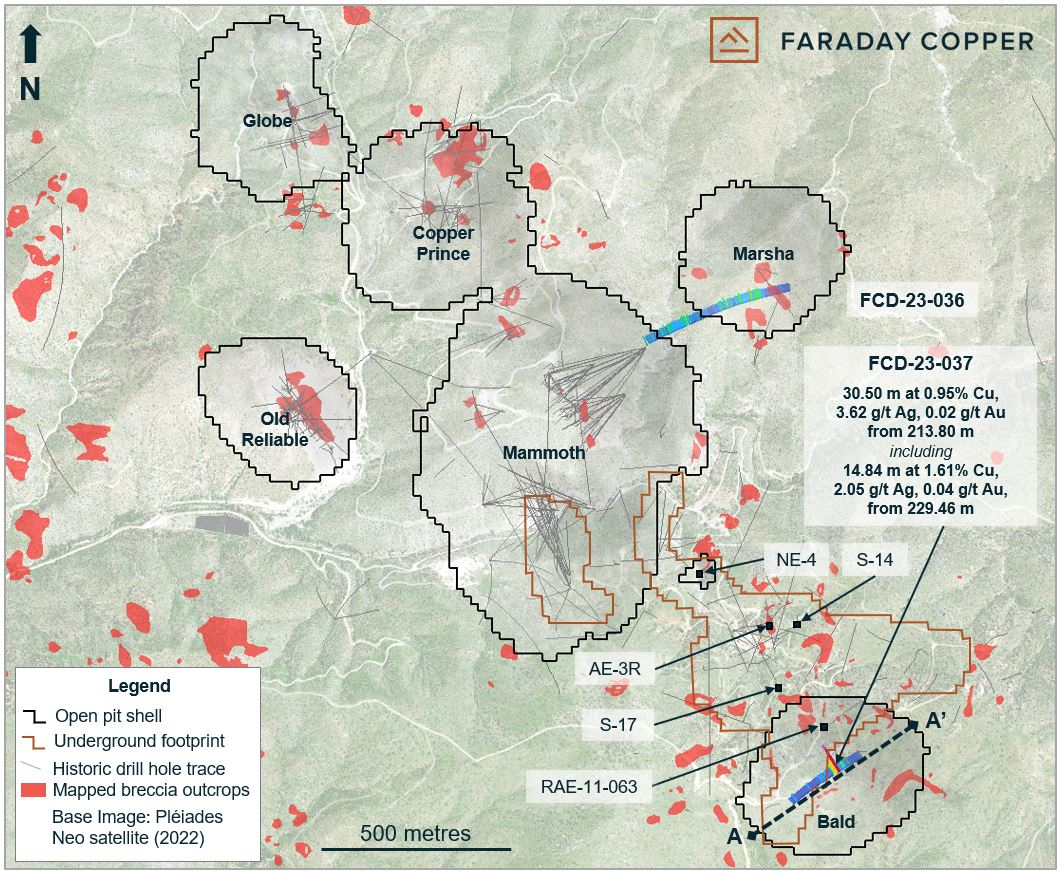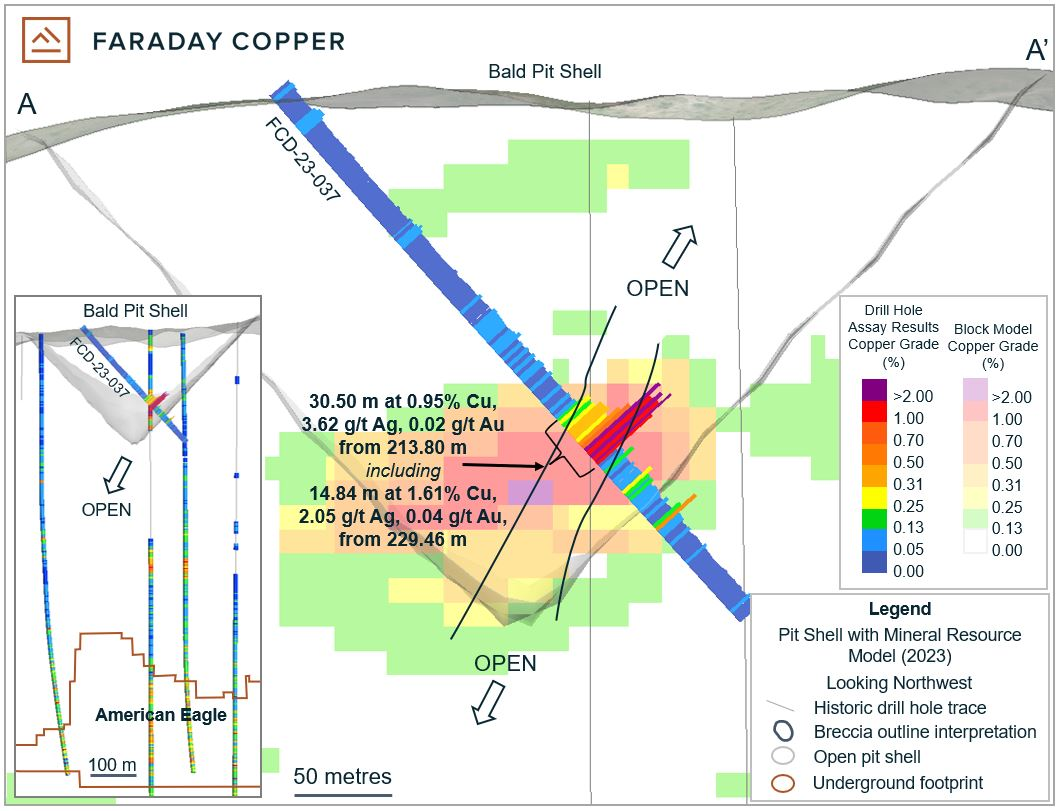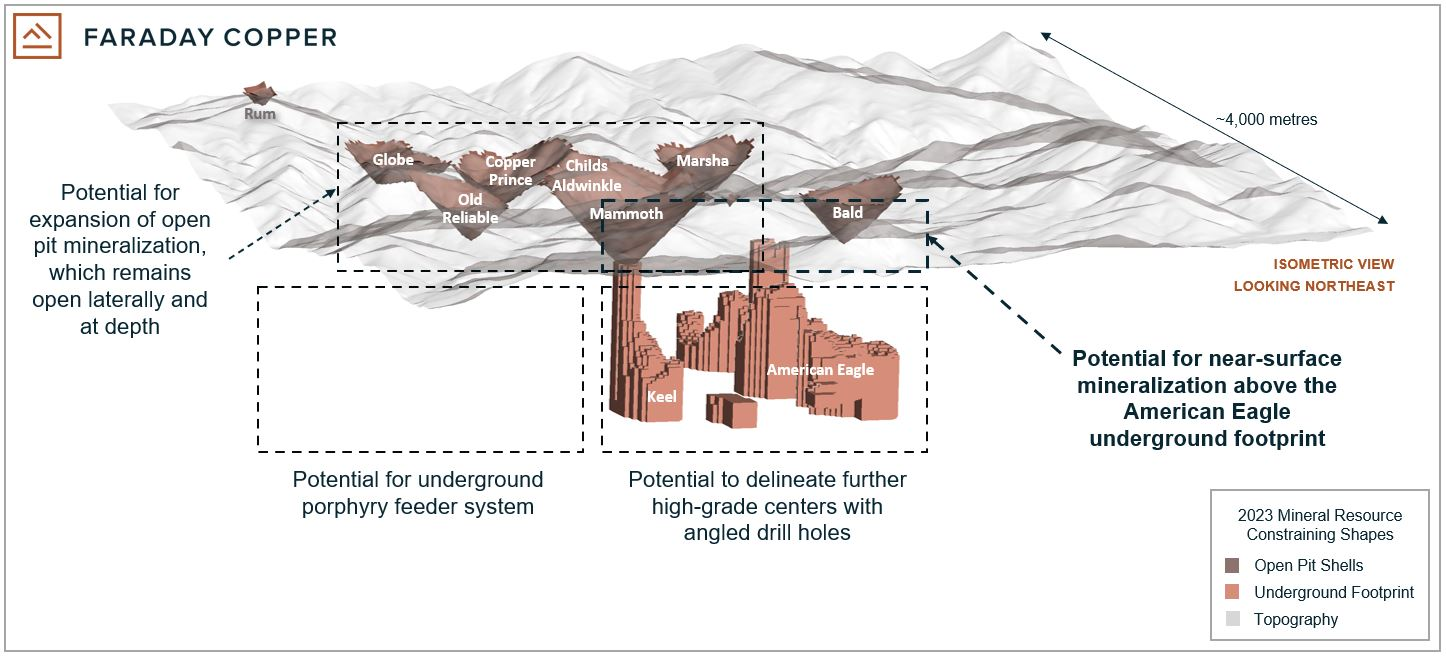
Faraday Copper (TSX:FDY) has disclosed the outcomes of the concluding two drill holes from the Phase II initiative at the Copper Creek Project, positioned in Arizona, USA. The purpose of these two holes was to evaluate the vertical extension of the breccia mineralization, above the American Eagle underground section, and target areas yet unexplored.
Drill hole FCD-23-037 started southwest of the Bald breccia and proceeded towards the northeast (Figures 1 and 2). This hole aimed to uncover the mineralization initially identified in a previous reverse circulation drill hole. FCD-23-037 was drilled as diamond core, showing that the mineralization is located in a crackle breccia made up of intensely sericite altered granodiorite fragments, glued together by chalcopyrite and pyrite (Figure 3). This breccia was intersected about 500 m above the American Eagle underground footprint. Historical extensive vertical drilling had not explored the vertical extension of this breccia, which is still open-ended. Further drilling in this area is slated as part of the Phase III program.

Drill hole FCD-23-036 commenced southwest of the Marsha pit shell and continued towards the northeast (Figure 1). The hole spans a drilling gap and verifies low-grade mineralization 160 m beneath the base of the Marsha pit shell utilized to limit the MRE. This drill hole points out that the Marsha area still offers prospects for resource expansion.
Historical drilling around the American Eagle region primarily targeted the gently dipping veins, which are crucial hosts of mineralization in the underground resource. The previous drilling was not ideally positioned for outlining the steeply dipping veins and breccia zones near the surface. Angled drilling in this zone is scheduled as part of the Phase III program to target open pit resource expansion.

Historical findings, along with drill hole FCD-23-037, between the Mammoth and Bald pit shells, covering about one kilometre, emphasize the potential for mineralization to be outlined above the American Eagle porphyry between the surface and a depth of 500 m. Some instances of historical drill results suggesting near-surface potential include (Figure 1):
- 18.29 m at 0.94% Cu from 85.34 m (AE-3R)
- 18.23 m at 0.84% Cu from 39.62 m (S-14)
- 27.32 m at 0.51% Cu from 186.54 m (RAE-11-063)
- 21.33 m at 0.34% Cu from 6.10 m (NE-4)
- 70.10 m at 0.38% Cu from 176.78 m (S-17)
The Phase II drilling, comprising a total of twenty-eight drill holes, concluded in June 2023. This press release includes the results of the final two drill holes.
To categorize and prioritize targets for the 20,000-meter Phase III drill program, the company is combining and interpreting multiple datasets, including geological mapping, drill core, geochemistry, hyperspectral data, airborne magnetic, and electromagnetic geophysical data. The Phase III drill program is set to begin in the final quarter of 2023 with the following three goals:
- Expanding the MRE
- Enhancing delineation of high-grade mineralized zones
- Reconnaissance drilling on fresh targets
A program to assay historical drill core samples has been launched to evaluate the potential for inclusion of gold in future resource updates. Historically, approximately 12 percent of all core samples analyzed for copper were also analyzed for gold. As part of the program, the first breccia to be analyzed is Childs Aldwinkle, with 359 samples submitted to the laboratory. Results will be publicized as they are received, analyzed and confirmed by the Company. Following the completion of the Childs Aldwinkle assaying, the Copper Prince, Pole, and Copper Giant breccias, as well as the Keel underground zone, will be prioritized for gold analysis.
The Phase II metallurgical program has started, focusing on grind size optimization to evaluate the feasibility of coarser particle flotation, gold deportment to concentrate, and further test work on near-surface mineralization.
Highlights from the results are as follows:
- Intersected 30.50 metres (“m”) at 0.95% copper, 3.62 g/t silver and 0.02 g/t gold from 213.80 m, including 14.84 m at 1.61% copper, 2.05 g/t silver and 0.04 g/t gold from 229.46 m in drill hole FCD-23-037 at the Bald breccia. (For true width information see Table 1)
- This result confirms near-surface, high-grade breccia mineralization within the Bald resource pit shell and highlights the potential for resource expansion above the American Eagle porphyry.
- Results from Phase II drilling, along with new geophysical data, spectral data and geological mapping, will contribute to ranking and prioritizing targets for a 20,000-metre Phase III drill program planned to commence in the fourth quarter of 2023.
- A metallurgical program has commenced and is focused on grind size optimization, gold deportment and further test work on near surface mineralization.
- Analysis of historical drill core for gold in selected breccias is in progress.
Table 1: Selected Drill Results from Copper Creek
| Drill Hole ID | From | To | Length | True Width | Cu | Mo | Au | Ag |
| (m) | (m) | (m) | (m) | (%) | (%) | (g/t) | (g/t) | |
| FCD-23-037 | 213.80 | 244.30 | 30.50 | 24 | 0.95 | 0.009 | 0.02 | 3.62 |
| including | 229.46 | 244.30 | 14.84 | 12 | 1.61 | 0.008 | 0.04 | 2.05 |
| FCD-23-036 | 447.54 | 487.12 | 39.58 | 39 | 0.16 | 0.006 | N/A | 0.41 |
Notes: All intercepts are reported as downhole drill widths. Mineralization includes bulk porphyry-style zones and breccia mineralization. Porphyry-style zones true widths are interpreted to be close to drilled widths. Breccia true widths are approximate due to the irregular shape of mineralized domains.
Table 2: Collar Locations from the Drill Holes Reported Herein
| Drill Hole ID | Easting | Northing | Elevation | Azimuth | Dip | Target | Depth | Depth |
| (m) | (°) | (°) | (ft) | (m) | ||||
| FCD-23-037 | 549088 | 3622920 | 1374 | 050 | -50 | Bald Breccia | 1148.0 | 349.91 |
| FCD-23-036 | 548678 | 3624198 | 1245 | 062 | -45 | Marsha Deep | 1968.0 | 599.85 |
Note: Coordinates are given as World Geodetic System 84, Universal Transverse Mercator Zone 12 north (WGS84, UTM12N).



 Follow us on Twitter
Follow us on Twitter Become our facebook fan
Become our facebook fan










Comments are closed.